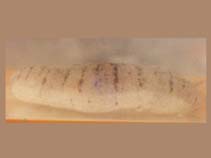Holothuroidea |
Holothuriida |
Holothuriidae
Environment: milieu / climate zone / تغييرات عمق / distribution range
بوم شناسي
وابسته به آب سنگ; تغييرات عمق 0 - 10 m (مرجع 122). Tropical; 30°N - 27°S, 32°E - 172°W (مرجع 107065)
Indo-Pacific, excluding Hawaii.
Length at first maturity / Size / Weight / سن
بلوغ: Lm ?, range 16 - ? cm Max length : 40.0 cm TL جنس نر / بدون خواص جنسي; (مرجع 418); common length : 22.0 cm TL جنس نر / بدون خواص جنسي; (مرجع 122); بيشينه وزن گزارش شده: 1.5 kg (مرجع 418)
Maximum total length: 35 cm, commonly 22 cm. Mean live weight: 300 g up to 1000 g (Ref. 122);1500 g (Ref. 418). Body-wall thickness: 0.6 cm. Body: oval, arched dorsally (bivium) and flattened ventrally (trivium). Bivium with characteristics wrinkles, covered by sediment when the animal is coming out of the bottom. Bivium with small papillae within black dots, and black podia ending in a disc of around 0.022 cm diameter; podia on trivium arranged irregularly, their calcareous disc around 0.035 cm in diameter. Mouth: ventral, surrounded by a collar of papillae and 20 grey, short and stout tentacles. Anus terminal, surrounded by a circle of 5 groups of radial papillae. Calcareous ring with a large medioventral radial piece. Cuvierian tubules absent. Color: highly variable; bivium whitish to dark brown, occasionally with dark transverse markings; trivium lighter, generally whitish. Spicules: very numerous; ventral tegument with tables and buttons, the tables having a moderately small disc, perforated by a varying number of holes of variable size, the spire with 4 pillars and a cross-like bridge, ending in a spiny crown with a hole in the middle; knobby buttons generally have 6 holes, occasionally more; small rods and denticulate plates also present; tables and buttons in dorsal tegument: tables with a nodose disc, much larger than in ventral tegument; buttons variable, larger, and more perforated than those in ventral tegument; ventral and dorsal podia with long and large spinose rods; tentacles with long spiny rods, small smooth rods, and large denticulate plates (Ref. 122).
Populations can reach high densities up to 1 per square meter. Provides the principal share of the tropical Indo-Pacific production of béche-de-mer and is harvested throughout the area in artisanal fisheries. Collected by hand while wading on the reefs at low tide. The processing method is particular of this species: the sea cucumbers are buried overnight, and the next day the numerous spicules are removed by brushing the tegument. The processed product is of major commercial value and at present highly demanded (Ref. 122). Found in shallow waters, rarely in depths of more than 10 m; mostly on inner reef flats of fringing and lagoon-islets reefs, coastal areas under terrigenous influence, and near mangroves. Burrows in mud and sandy-muddy bottoms (Also Ref. 129602) where the populations can reach high densities up to 1 per square meter (Ref. 122). Found in silty sand, often near low saline areas and frequently on Cymodocea sp. beds, from the intertidal to a depth of 10 m. It buries in sand part of the day but is gregarious in nature (Ref. 118). Also found in intertidal seagrass beds (Refs. 106849, 129602). Benthic detritus feeder; assimilates organic matter from muddy sandy sediments, among other food sources (Ref. 101695).
Sexual reproduction takes place during warm season. A species with a high potential fecundity and early sexual maturity (Ref. 122).
مآخذ اصلی
مراجع | هماهنگ كننده | همكاران
Conand, C. 1998 Holothurians (sea cucumbers, Class Holothuroidea). p. 1157-1190. In Carpenter, K.E. and V.H. Niem (eds.) FAO Species Identification Guide for Fishery Purposes. The Living Marine Resources of the Western Central Pacific. Vol. 2. Cephalopods, crustaceans, holothurians and sharks. FAO Rome. (مرجع 122)
وضعيت در فهرست قرمز IUCN
(مرجع 130435: Version 2025-1)
وضعيت از نظر سايتس (مرجع 108899)
Not Evaluated
Not Evaluated
خطر برای انسان ها
استفاده انسانی
ماهي گيري – شيلات: با ارزش تجاري بالا
| FishSource |
ابزارها
اطلاعات بيشتر
PhysiologyOxygen consumption
Human RelatedStamps, coins, misc.
منابع اينترنتي
Estimates based on models
Preferred temperature
(Ref.
115969): 25.8 - 29.3, mean 28.6 (based on 2941 cells).
جهندگی
زياد, كمينه زمان لازم براي دو برابر شدن جمعيت ، كمتر از 15 ماه (K=0.52).
Fishing Vulnerability
Moderate to high vulnerability (53 of 100).
طبقه قيمت
Unknown.




